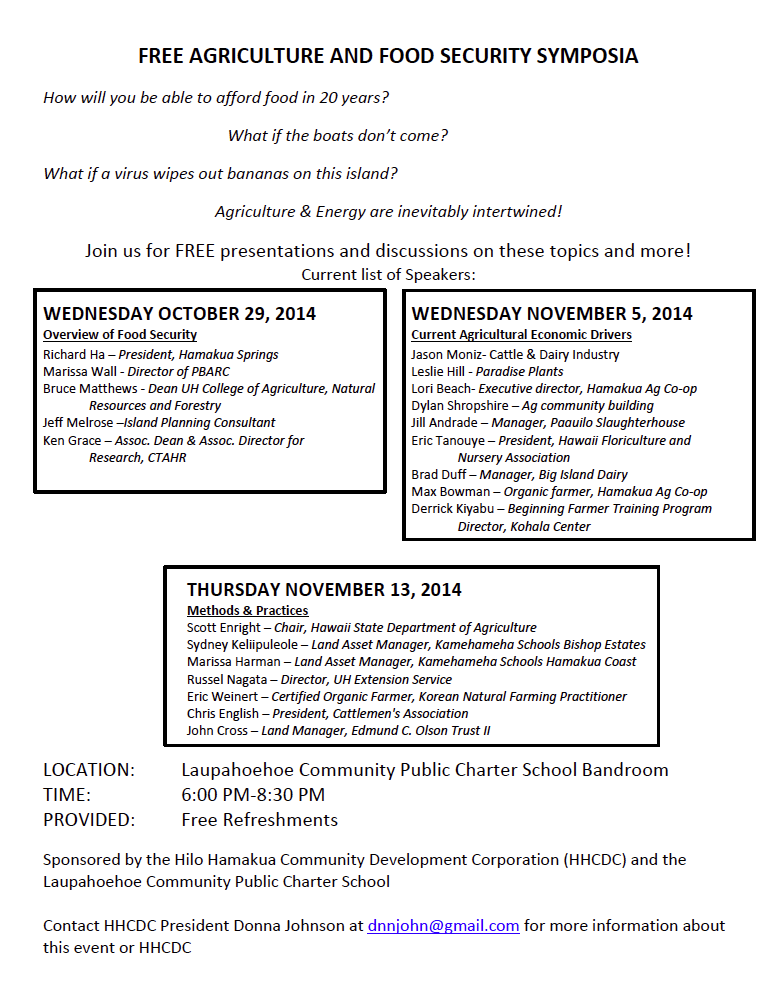I asked Dr. Bruce Mathews, interim dean of the College of Agriculture, Forestry and Natural Resource Management (CAFNRM) at the University of Hawai‘i at Hilo (UHH), to write a guest post about speaking at the first of our community meetings on agriculture and food security.
Dr. Mathews writes:
Mahalo for inviting me to present an overview of Hawaii’s soil resource base for agriculture from the pre-European contact era to the present during the first part of HHCDC Symposia Series on Agriculture and Food Security.
I found that the speakers during the first session provided a solid overview of the current realities facing our local agriculture from all perspectives (resources, new precision technologies, economics, policies, etc.). I appreciated the candid discussions regarding the growth constraints faced by many crop sectors as long as there is strong import competition from continental-based operations (CBOs) and heavy dependence on imported energy and nutrient inputs for our farms.
At the end of my talk I shared a bit about my concerns regarding what I called sustainability madness and ecological imperialism. Many people are very concerned about local use of agricultural chemicals (mainly synthetic biocides such as pesticides, herbicides, etc.) and GMOs, yet the majority in Hawaii consume foods every day that are imported from CBOs where synthetic biocides and (or) GMOs were used in their production.
No doubt there is quite a bit of not in my back yard (NIMBY) ecological imperialism/ecological hypocrisy going on here and this has implications for local society as a whole.
On the other side of the coin, the best genetic manipulations in the world won’t work for long to support economic yields if we cultivate soils depleted of nutrients, organic matter, and beneficial microbial and faunal balance. The problems of climate change such as drought will only be magnified in such soils.
Yesterday I met with a group of current and former UH Hilo College of Agriculture, Forestry, and Natural Resource Management (CAFNRM) students who had leased some land with relatively good soil to farm but recently gave up the lease after raising several different truck crops. Some of the dilemmas that they mentioned facing were the lack of viable organic options to control certain pests, time and labor needed to control weeds when herbicides were not used, security challenges, etc. Obviously, they could not sell much of what did not grow well without effective pest and weed control. There is some zealous Garden of Eden like idealism that permeates the thinking of many until they have faced the reality of actually trying to farm in Hawai‘i.
I hope that my talk also brought to light that with increasing population and cropping intensification Native Hawaiians in the pre-European contact era indeed faced challenges and threats to sustainability despite far fewer constraints posed by invasive species.
Finally, I trust human ingenuity and integrated approaches to solve the challenges we currently face. In contrast to the polarized, advocacy-based discussions seen at some recent agricultural meetings, the dialogue at the first session of this symposia was surprisingly well-received, cordial, deep, and meaningful.
The challenges that agriculture faces in Hawaii demand an open and understanding approach based on the best scientific and verifiable on-farm evidence available so that we can best self-correct as a society for a more sustainable future.
I look forward to attending the 2nd and 3rd sessions of the symposia series.
The three-part symposium is being hosted by the Hilo Hamakua Community Development Corporation, and, as Dr. Mathews mentioned, the first one went well.
The next two meetings are November 5th and November 13th; both are from 6-8 p.m., in the Laupahoehoe Community Public Charter School Bandroom.
The meetings are open to the public; please come if you’re interested. Read more here.

